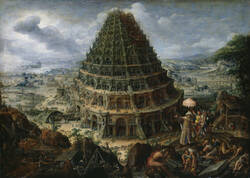The legendary Tower of Babel, a massive, pyramid-like circular structure, towers over a vast, diverse landscape consisting of several different geographical regions. The structure is already inhabited on all floors which are connected by countless staircases and the impression is created that it contains the diverse life of an entire city within its walls. In the darker foreground the legendary king Nimrod, the builder of the tower, is seen under a parasol with his entourage. He is inspecting the workers involved in numerous different trades to complete the construction.
Depictions of the Tower of Babel were one of the most popular and sought-after subjects in landscape painting north of the Alps at the turn of the 17th century. The biblical story of the building of the tower has an existential dimension for the structure reaching "up to heaven" is a symbol of the failure of mankind in its efforts to measure up to God. However, the focus here is not on the destruction of the tower or the scattering of humanity but on the collective striving for the completion of a structure that surpasses all human measure and claims to be like God.
Further Media
The story of the Tower of Babel is recounted in the Old Testament book of Genesis, and is set after the Flood. The population has recovered again, with people settling on a plain in a land called Shinar. They then started to build.
‘Come,’ they said, ‘let us make bricks and bake them thoroughly. Let us build ourselves a city with a tower that reaches to the heavens, and let us make a name for ourselves.’
When God saw the half-finished tower, He feared the worst.
‘Behold, they are one people, and they all have the same language, and this is only the beginning of what they will do. And nothing they propose to do will now be impossible for them.’
People wanting to compete with God – unthinkable! It was time to put an end to their plans. But, as the biblical account explains, God did not want to send a second Flood. Instead, He mixed up their languages so people could no longer understand each other, and then scattered them across the face of the earth.
The artist Marten van Valckenborch resorted to a trick of perspective to ensure the Tower seems truly massive to the viewers of this work. He combines three different perspectives, so we see the lower section of the tower from a bird’s eye perspective – as if we were looking down on it. In the central section, he used the standard linear perspective. In contrast, we feel we are looking up at the upper section from below, a perspective artificially creating a strong impression of the tower’s height.
- Location & Dating
- 1595
- Material & Technique
- Oil on oak panel
- Dimenions
- 75,5 x 105 cm
- Museum
- Gemäldegalerie Alte Meister
- Inventory number
- Gal.-Nr. 832

